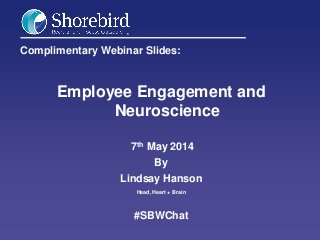
Employee Engagement and Neuroscience Webinar Slides
- 1. Complimentary Webinar Slides: Employee Engagement and Neuroscience 7th May 2014 By Lindsay Hanson Head, Heart + Brain #SBWChat
- 2. A little bird told me…. 0113 322 7240 marketing@shorebird-rpo.com www. shorebird-rpo.com SHOREBIRD ATTRACT SHOREBIRD MANAGE SHOREBIRD SUPPORT Help companies with their direct hiring strategy
- 3. Employee Engagement – What can we learn from neuroscience? Lindsay Hanson, Head Heart + Brain
- 4. The Neuroscience of Leadership Head Heart + Brain Employee Engagement and Neuroscience
- 5. What I am going to cover Employee Engagement and Neuroscience What we mean by engagement and why it matters What are the drivers of engagement? Three neuroscience principles A brain-savvy charter for leaders
- 6. “Employee engagement is a heightened emotional connection felt by the employee for the organisation which drives more discretionary effort” What do we mean by employee engagement? Employee Engagement and Neuroscience
- 7. Why does engagement matter? Employee Engagement and Neuroscience
- 8. It matters! Employee Engagement and Neuroscience Stock Market Performance and Shareholder returns High engagement (65% or more) equals outperformance of the stock market index and higher shareholder returns of 22%. Companies with low engagement (45% or less) had shareholder returns 28% lower than the average. Individual performance On an individual level, highly engaged employees overall performance scores were 20 percentile points higher than those of employee with average levels of engagement. The Corporate Leadership Council Individual performance Sales in an insurance sales office demonstrated that those who were highly engaged outperformed the disengaged by 28%. Bates Customer Service Companies with high employee engagement scores had a corresponding level of customer loyalty (repeat purchases, recommendation to friends etc.) at twice the level of companies with average employee engagement levels. Pont
- 9. What drives engagement? Employee Engagement and Neuroscience • Trust and integrity • Nature of the job • Line of sight • Take pride • Pride in company • Relationship with team members • Learning and growth • Relationship with line manager
- 10. Three principles: Threat and reward We are social beings not economic Form in-groups and out-groups So what can we learn from neuroscience? Employee Engagement and Neuroscience
- 11. The Neuroscience of Leadership Threat and reward Employee Engagement and Neuroscience
- 12. The Neuroscience of Leadership Social connection Employee Engagement and Neuroscience
- 13. In-group Out-group Employee Engagement and Neuroscience
- 14. Brain-savvy leaders - a charter Employee Engagement and Neuroscience So what do brain-savvy leaders do: Their leadership style contributes to a sense of reward rather than a sense of threat Communicates a clear vision to give people certainty They ask “how do you think that went?” Rather than giving them direct feedback Clearly articulate the goal and let them work out how they get there Builds engagement through asking question Treats team fairly and consistently Focus on building deep relationships with direct reports Asks how employees are feeling not just what they think Focus on relationships between team members Look to create harmony and shared pride in work Look to break down barriers/silos across the team Know how to build bonds across these divisions 44% of managers believe they excel at people management. Based on an assessment by their reports and peers, only 14% actually do.
- 15. Brain-savvy HR – an evidence base Employee Engagement and Neuroscience www.headheartbrain.com E lindsayhanson@hhab.co.uk M 07786 070235 T @headheartbrain
- 16. The Neuroscience of Leadership Any questions? Employee Engagement and Neuroscience
- 17. • View more FREE webinars at www.shorebird-rpo.com/free-webinars • Join our LinkedIn Group to access slides and recordings http://linkd.in/1acZPdh • Connect on social media Thank you 0113 322 7240 sales@shorebird-rpo.com www. shorebird-rpo.com
- 18. Next weeks Webinar: Recruitment Agency Terms of Business: Where do Employers Stand? 14th May 2014 By Hugh Middlemass Winston Solicitors LLP Click here to register
